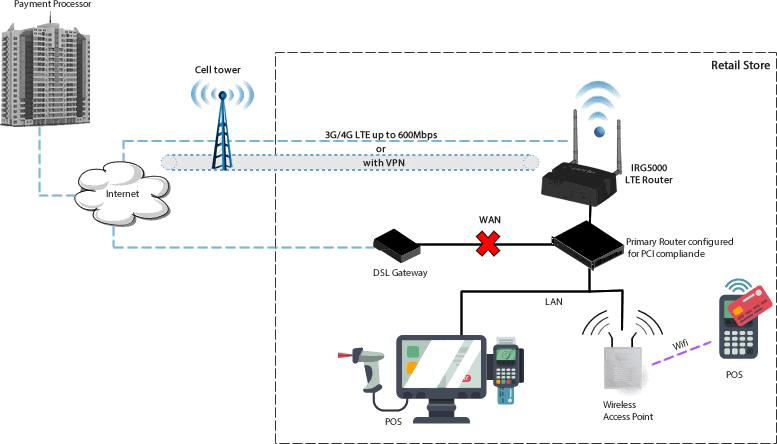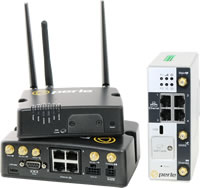Keeping Contactless Payment Systems Up and Running
There is nothing more frustrating for a cashier, or a customer with no cash on hand, to be told that the connection to the payment processor is down. A look at how LTE Routers help solve the problem.
PRINCETON, N.J. (July 02, 2020) The push to re-open restaurants, salons, and all forms of brick and mortar retail stores have people scrambling to implement hygienic and safe ways of making proximity payments. To lure staff and consumers back, they must create environments where people feel their health and safety are protected. Limiting the number of people inside, utilizing masks, enforcing physical distancing rules, and placing protective screens at checkouts are often discussed. An additional measure is to encourage digital payments, instead of cash, for completely contactless transactions.
Contactless is considered the more hygienic and safe way of making proximity payments. Although the trend toward contactless payment was well in place before the current pandemic, COVID-19 has created a surge as consumers and retailers reconsider how they handle cash.
"COVID-19 is not only bringing contactless to the forefront of the digital payment experience, but also other next-generation payment card form factors. As consumers increasingly use and become more reliant on contactless, the question of how best to secure and limit fraud on increasing contactless transaction volumes and values will come into play," says Phil Sealy, Research Director at ABI Research.
The credit card industry requires retailers to comply with the Payment Card Industry (PCI) standard to maintain a secure environment when processing payment card transactions. For these transactions, routers and POS (point-of-sale-terminals) on the network must be configured for PCI compliance. The USBnet must be on a different subnet from the point-of-sale-terminal and all security protocols must be established from the point-of-sale terminal to the payment processor. Payment card terminals must be on a dedicated LAN or VLAN. But there is nothing more frustrating for a cashier, or a customer with no cash on hand, to be told that the connection to the payment processor is down. It happens all the time. And this scenario can be more detrimental to a struggling brick and mortar store than ever before. The solution is to have an LTE Router act as a wireless data conduit (Gateway).

Imagine a restaurant, retail store, pop-up store, kiosk, construction site, or any temporary location, that has the typical 99.5% landline availability. The 0.5% annual downtime can cost them more than $1 million. LTE Routers, with Dual-SIM failover, can provide the primary or back-up LTE coverage for business-critical equipment to ensure customers continue to be served.
Perle Systems, a global provider of advanced networking hardware, has released an extensive line of IRG5000 LTE Routers & Gateways that are certified for operation on 33 LTE bands internationally and have speeds up to 600Mbps downlink and 150Mbps uplink.
John Feeney, COO at Perle Systems comments, “IRG5000 routers and gateways enable users to leverage the reliability and flexibility of cellular networking to minimize downtime, reduce service calls, and bring branch office and temporary locations online faster than any other solution.”
When the wired link is down, network access can be maintained with automatic failover to LTE. There are several ways to determine when the Primary WAN is down. For example, the IRG5000 Health Monitoring function will ping a destination IP through the primary route. If there is no response, the IRG5000 router will initiate a direct connection using the back-up LTE route. The IRG5000 can be configured for numerous conditions to automatically trigger a failover.
Perle IRG5000 LTE Routers also have more extensive protocol routing support than any other LTE Router in its class. With RIP, OSPF, BGP-4, IPv4, IPv6, OpenVPN, IPSec VPN, and DHCP, any IRG5000 router can be easily deployed in hierarchical or large mesh network structures to operate as a router or gateway.
An integrated zone-based policy firewall, 2 Factor Authentication, and remote authentication (RADIUS, TACACS+) management, ensures IRG5000 Routers integrate seamlessly with enterprise-grade systems to control access to devices in the field and protect inside networks from unauthorized users.
With 16 concurrent VPN sessions and 3DES encryption, Perle IRG5000 routers ensure data privacy and secure communications to multiple back-end systems. And, end-to-end protection of the software upgrade process protects devices against unwanted malware.
In addition, IRG5500 Routers with Dual-band Wi-Fi, are an easy to install "all-in-one" solution. This single box will function as an LTE Router, two-port or four-port 10/100/1000 Ethernet Switch, and Wi-Fi Access Point that allows up to 128 clients to work simultaneously.
The relatively low cost of LTE for business continuity means a greater return on investment and scalability for multiple locations that have limited IT resources. By deploying Perle IRG5000 LTE Routers, businesses will have on-demand network connectivity that is quick to set-up, simple to manage, and ensures maximum uptime.
Find out more about Perle IRG5000 LTE Routers & Gateways.
